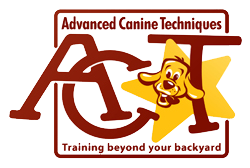What is PACT?
As January 2014 comes to a close and I have been teaching classes for about 4 weeks, I came up with this acronym that may help owners work with their dogs. You can use the PACT method. It is easy to remember and helps owners focus on their attitude and energy in addition to the outcomes they want from the dog. PACT stands for Patience, Attitude, Consistency and Timing. Let’s break all 4 of these words down.
Patience is critical when teaching a dog a new skill or behavior. You need to break the behavior down in small steps (shape it) and then reward each step in small increments. This also applies to any type of behavior modification. Your dog will not immediately stop nuisance behaviors that he has been previously rewarded for. I do believe some type of aversive is appropriate and that we need to teach the dog an acceptable alternate behavior but I also believe we need to give the dog a chance to process what we ask before we quickly give up. Teaching down and stay are perfect examples of using patience. I usually use the lure method to teach a dog to down but if that method doesn’t work, I will try to shape it by getting them to lay down under my leg or under a place board. If that fails, I will try to gently pull the leash under my foot to get a down and then quickly release once I get the desired behavior. The point is that I have a few different methods that I can use but I will not give up on the dog. When I lure, I will try bringing the treat straight down to the floor from the dogs nose slowly and possibly either pushing the treat towards the dog trying to get the dog to back into a down or pulling the treat toward me to get a down. I have also just held the treat on the floor and waited the dog out as well. If the owner gets frustrated, anxious or pushes on the dogs back, the dogs gets distracted and gives up.
Attitude- I believe this is critical when working with dogs. You need to project confidence and a positive attitude when working with your dogs. It would be like going to work and never getting recognition for your job or being told that you didn’t get it right over and over again (think of Office Space and the TPS reports). If you project an attitude of confidence and break down the training behavior in small steps, you and your dog are likely to be much more successful. Reward the baby steps first and soon you will find you can take larger steps and reward less often.
Consistency is another critical component of training. Dogs live in a black and white world so if they sit and get rewarded they will keep offering that behavior. Consequently if they dig in the trash and get corrected, that behavior will decrease. Jumping up and pulling on leash are the best examples. Owners or friends reinforce the jumping up and then get mad when she does jump up so the rules are inconsistent. The same consistency applies to pulling on the leash. If you allow the dog to pull on walks or use a retractable leash, then get upset when they pull, you are sending mixed messages to your dog. Ideally I like to give them some freedom on a longer lead (10-20 feet) and give them a “go sniff” “go potty” or “free” command but then use a six foot leash and teach them to either “let’s go” or “heel.” I am now giving the dog very specific commands to aid in their decision making. Short leash means walk next to me and longer lead means you have some freedom outdoors.
Lastly, timing is also important. The instant your dog offers the correct behavior, they should be rewarded with praise, petting or treats. You also want to “time” your corrections immediately as well. Ideally if you can correct before the behavior occurs (counter surfing for example), it will help diminish that behavior. The same rule applies to jumping up. When your dog leaves the neighbor dog along, potties outside on command, and offers a quick behavior such as a sit, a fast and prompt reward should follow. If you take too long to correct or reward, you may be unintentionally rewarding or correcting the wrong behavior. Using bait bags work well because you have quick access to toys and treats to immediately reward good behavior.
If you are able to follow all 4 of these guidelines, you will set your dog up for success and have a safe, fun and rewarding training adventure together.
We love stories so share with us if you have used any of these guidelines to help train your dog.
